|
|
|
Sort Order |
|
|
|
Items / Page
|
|
|
|
|
|
|
| Srl | Item |
| 1 |
ID:
114022


|
|
|
|
|
| Publication |
2012.
|
| Summary/Abstract |
American military institutions importantly shaped the popular sport of college football. From support at its two oldest service academies, interest in football spread through military units across the country with military actors involved in the formation of the country's first collegiate athletic conference and the National Collegiate Athletic Association. Subsequently, the US military functioned as an agent of authoritative diffusion, fostering interest in college football after the First World War. Furthermore, military institutions, including the draft, affected not only which team would be most successful during the Second World War but also how civilians would play the game. These effects call to mind Charles Tilly's work on state formation and security-driven resource extraction as well as Harold Lasswell's garrison state idea.
|
|
|
|
|
|
|
|
|
|
|
|
|
|
|
|
| 2 |
ID:
101329
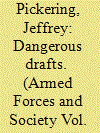

|
|
|
|
|
| Publication |
2011.
|
| Summary/Abstract |
Conscription has been claimed to both increase leaders' propensity to use military force abroad and constrain them from doing so. The author sheds new light on this longstanding controversy by presenting the first time-series, cross-national quantitative analysis of the impact that state military manpower systems (either conscription or volunteerism) have on the initiation of both traditional, belligerent military missions and "operations other than war" (OOTWs). Using negative binomial regression on 166 states from 1946 to 2001, the author finds that states with conscript militaries have a significantly higher propensity to use belligerent military force than states with volunteer armies. Countries that practice conscription are also more likely than countries with volunteer forces to launch a specific type of OOTW, military operations against nonstate actors such as rebels or terrorists. Neither form of military manpower system seems, however, to be significantly related to the initiation of humanitarian military operations.
|
|
|
|
|
|
|
|
|
|
|
|
|
|
|
|
| 3 |
ID:
107663


|
|
|
|
|
| Publication |
2011.
|
| Summary/Abstract |
With establishment of the U.S. Selective Service System in 1917, selective draft rules placed consideration of registrants' economic obligations to their dependents front and center. By observing the Canadian and British recruitment experiences, American policy makers opted against universal conscription since they believed it would be costly because of the need to offer family allowances and opted against a voluntary system since they believed that too many bachelors would fail to volunteer. Dependency deferments were designed to minimize the social and economic costs of war. Local board members determined whether a man was a genuine breadwinner or not, and individual discretion on this matter contributed to the higher rates of African American draftees during WWI compared to white draftees, since African American men were less likely to be recognized as genuine breadwinners. Selective Service rules thus resulted in reproducing female citizens as economic dependents and yielded durable inequalities among registrants.
|
|
|
|
|
|
|
|
|
|
|
|
|
|
|
|
| 4 |
ID:
027980
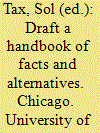

|
|
|
|
|
| Publication |
Chicago, University of Chicago Press, 1967.
|
| Description |
xiii, 497p.
|
|
|
|
|
|
|
|
|
|
|
|
Copies: C:1/I:0,R:0,Q:0
Circulation
| Accession# | Call# | Current Location | Status | Policy | Location |
| 000527 | 355.03355694/TAX 000527 | Main | On Shelf | General | |
|
|
|
|
| 5 |
ID:
151017
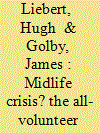

|
|
|
|
|
| Summary/Abstract |
Owing to regional and partisan imbalances, the U.S. military is at greater risk than at any time since the advent of the all-volunteer force of becoming estranged from significant portions of the society it serves. What—if anything—should be done? This article takes three initial steps to address this problem. First, the article examines regional and partisan representation in the U.S. military and suggests that existing imbalances are likely to grow worse over time. The article then argues that the most obvious policy response, a renewed draft, would in fact fail to adequately bridge the gap. Finally, the article outlines one policy response—the reassertion of nonpartisan norms—that would help to mitigate, though not close, the gap.
|
|
|
|
|
|
|
|
|
|
|
|
|
|
|
|
| 6 |
ID:
101328
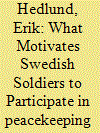

|
|
|
|
|
| Publication |
2011.
|
| Summary/Abstract |
During the last ten years, the Swedish Armed Forces has undergone a transformation in its shift toward worldwide peacekeeping operations. Subsequently, the Swedish government is moving away from conscription to an all-voluntary recruitment system. This transition may lead to substantial challenges in recruiting new soldiers for the Armed Forces as well as for peacekeeping operations. A key to successful recruitment is understanding what motivates young men and women to participate in peacekeeping operations. This research note addresses questions about what motivated Swedish peacekeeping soldiers to join the 5th mission to Liberia and the 14th mission to Kosovo in 2006. Fabrizio Battistelli's motivation typology, paleomodern, modern, and postmodern, is used in the analysis. The results show that all three motives were represented but that postmodern motives were by far the most common motivator.
|
|
|
|
|
|
|
|
|
|
|
|
|
|
|
|
| 7 |
ID:
131363
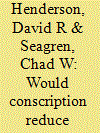

|
|
|
|
|
| Publication |
2014.
|
| Summary/Abstract |
An increasingly popular justification for conscription is that it would increase the probability that the "children" of politically powerful people would serve in the military, thus giving them an incentive to lobby against war. However, this argument neglects the fact that avoiding war for a nation is a public good and is, therefore, subject to the classic free-rider problem. Under-provision of anti-war agitation from those seeking to avoid the draft is exacerbated by the fact that seeking a deferment provides an alternative with a superior private payoff. Empirical findings since World War II are consistent with our thesis.
|
|
|
|
|
|
|
|
|
|
|
|
|
|
|
|
|
|
|
|
|